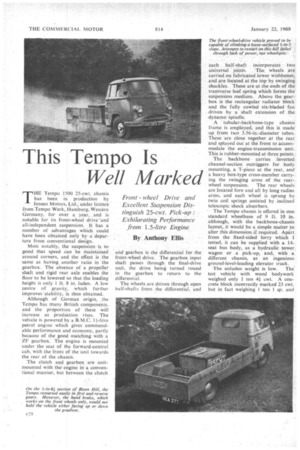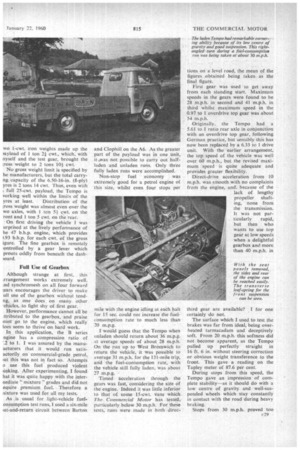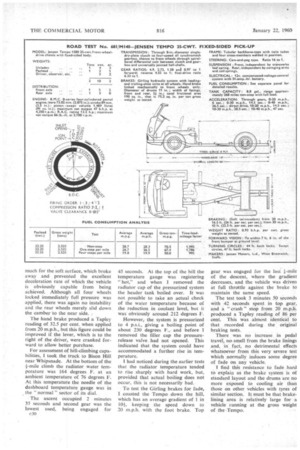This Tempo Is Well Marked
Page 66

Page 67

Page 68

Page 69

If you've noticed an error in this article please click here to report it so we can fix it.
Front -wheel Drive and Excellent Suspension Distinguish 25-cwt. Pick-up : Exhilarating Performance from 1.5-litre Engine By Anthony Ellis
THE Tempo 1500 25-cwt. chassis has been in production by Jensen Motors, Ltd., under licence from Tempo Werk, Hamburg, Western Germany, for over a year, and is notable for its front-wheel drive-and all-independent suspension. It has a number of advantages which could have been obtained only by a departure from conventional design.
Most notably, the suspension is so good that speed can be maintained around corners, and the effect is the same as having another ratio in the gearbox. The absence of a propeller shaft and rigid rear axle enables the floor to be lowered so that the loading height is only 1 ft. 8 in. laden. A low centre of gravity, which further improves stability, is thus obtained.
Although of German origin, . the Tempo has many British components. and the proportion of these will increase as production rises. The vehicle is powered by a B.M.C. 1-litre petrol engine which gives commendable performance and economy, partly because of the good matching with a ZF gearbox. The engine is mounted under the seat of the forward-control cab, with the front of the Unit towards the rear of the chassis.
The clutch and gearbox are unitmounted with the engine in a conventional manner, but between the clutch and gearbox is the differential for the front-wheel drive. The gearbox input shaft passes through the final-drive unit, the drive being turned round in the gearbox to return to the differential.
The wheels are driven through open half-shafts from the differential, and each half-shaft incorporates two universal joints. 'The wheels are carried on fabricated lower wishbones, and are located 'at the top by swinging shackles. These are at the ends of the transverse leaf spring which forms the suspension medium. Above the gearbox is the rectangular radiator block and the fully cowled six-bladed fan driven by a shaft extension of the dynamo spindle.
A tubular-backbone-type chassis frame is employed, and this is made up. from two 3.56-in.-diameter tubes. These are close together at the rear and splayed out at the front to accommodate the engine-transmission unit. This is rubber-mounted at three points.
The backbone carries inverted channel-section outriggers for body mounting, a T-piece at the rear, and a heavy box-type cross-member carrying the swinging arms of the rear wheel suspension. The rear wheels are located fore and aft by long radius arms, and each wheel is .sprung by twin coil springs assisted by inclined telescopic shock absorbers.
The Tempo chassis is offered in one standard wheelbase of 9 ft. 10 in. although, with the backbone-chassis layout, it would be a simple matter to alter this dimension if required. Aprt from the fixed-sided lorry which 1 tested, it can be supplied with a 14seat bus body, as a hydraulic tower wagon or a pick-up, and, with a different chassis, as an ingenious ground-level-loading elevator truck.
The unladen weight is low. The test vehicle with wood bodywork weighed only 1 ton 4-1 cwt. A concrete block incorrectly marked 23 cwt. but in fact weighing 1 ton 1 qr. and wo 1-cwt. iron weights made up the )ayload of 1 ton 24cwt., which, with nyself and the test gear, brought the ;ross weight to 2 tons 10+ cwt.
No gross weight limit is specified by he manufacturers, but the total carryng capacity of the 6.50-16-in. (8-ply) yres is 2 tons 14 cwt. Thus, even with . full 25-cwt, payload, the Tempo is vorking well within the limits of the
yres at least. Distribution of the ;ross weight was almost even over the wo axles, with 1 ton 54: cwt. on the rent and I ton 5 cwt. on the rear.
On first driving the vehicle 1 was urpriscd at the lively performance of he 47 b.h.p. engine, which provides ).93 b.h.p. for each cwt. of the gross igure. The fine gearbox is remotely :ontrolled by a gear lever which prouts oddly from beneath the dashmard.
Full Use of Gearbox
Although strange at first, this irrangement works extremely well. ,nd synchromesh on all four forward :ears encourages the driver to make nil use of the gearbox without tendng, as one does on many other chides, to fight shy of. first gear.
However, performance cannot all be ttributed to the gearbox, and praise nust go to the engine, which realty toes seem to thrive-on hard work.
In this application, the B series ngine has a compression ratio of '.2 to 1. I was assured by the man uacturers that it would run satisactorily on commercial-grade petrol, tut this was not in fact so. Attempts a use this fuel produced violent inking. After experimenting, I found hat it was quite happy with the internediate "mixture " grades and did not equire premium fuel. • Therefore a nixture was used for, all my tests.
As is usual for light-vehicle fuelonsumption test runs, I used a six-mile iut-and-return circuit between Barton
and Clophill on the A6. As the greater part of the payload was in one unit, it was not possible to carry out halfladen and unladen runs. Only three fully laden runs were accomplished.
Non-stop fuel economy was extremely good for a petrol engine of this size, whilst even four stops per mile with the engine idling at each halt for 15 sec. could not increase the fuelconsumption rate to much less than 20 m.p.g.
I would guess that the Tempo when unladen should return about 36 m.p.g. at average speeds of about 28 m.p.h.. On the run up to West Bromwich to return the vehicle, it was possible to average 31 m.p.h. for the 131-mile trip, arid the fuel-consumption rate, with the vehicle still fully laden, was about 27 m.p.g.
Timed acceleration through the gears was fast,. considering the sizeof the engine. Indeed it was little inferior to that of some 15-cwt. Vans" which" The Commercial Motor has tested, particularly below 30 m.p.h.. For these tests, runs were made in both direc
tions on a level road, the mean of the figures _obtained being taken as the final figure.
First gear was used to get away from each standing start. Maximum speeds in the gears were found to be 28 m.p.h. in second and 41 m.p.h. in third whilst maximum speed in the 0.97 to 1 overdrive top gear was about 54 m.p.h.
. Originally, the Tempo had a 5.61 to 1 ratio rear axle in conjunction with an overdrive top gear, following German practice, but sensibly this has now been replaced by a 6.33 to 1 drive unit. With the earlier arrangement, the top speed of the vehicle was well over 60 m.p.h., but the revised maximum speed is quite adequate and provides greater flexibility.
Direct-drive acceleration from 10 m.p.h. was smooth with no complaints from the engine, and, because of the lack of lengthy propeller shaft ing, none from the transmission. It was not par ticularly rapid, but then who wants to use top gear at low speeds when a delightful gearbox and more than 40 m.p.h. in third gear are available? I for one certainly do not.
The surface which I used to test the brakes was far from ideal, being overheated tarmacadam and deceptively soft. From 20 m.p.h. this softness did not become apparent, as the Tempo pulled up perfectly straight in 16 ft. 6 in. without steering correction or obvious weight transference to the front. This gave a reading on the Tapley meter of 87.6 per cent.
During stops from this speed, the Tempo .gave an impression of complete stability—as it should do with a low centre of gravity and well-suspended wheels which stay constantly in contact with the road during heavy braking.
Stops from 30 m.p.h. proved too e29 much for the soft surface, which broke away and prevented the excellent deceleration rate of which the vehicle is obviously capable from being achieved. Although all four wheels locked immediately full pressure was applied, there was again no instability and the rear wheels merely slid down the camber to the near side. , The band brake produced a Tapley reading of 32.5 per cent, when applied from 20 m.p.h., but this figure could be improved if the lever, which is to the right of the driver, were cranked forward to allow better purchase.
For assessment of hill-climbing capabilities, I took the truck to Bison Hill near Whipsnade. At the bottom of the climb the radiator water temperature was 164 degrees F. at an ambient temperature of 76 degrees F. At this temperature the needle of the dashboard temperature gauge was in the " normal" sector of its dial.
The ascent occupied 2 minutes 35 seconds and second gear was the lowest used, being engaged for c30
45 seconds. At the top of the hill the temperature gauge was registering ".hot," and when I removed the radiator cap of the pressurized system the header tank boiled over. It was not possible to take an actual check of the water temperature because of the reduction in coolant level, but it was obviously around 212 degrees f.
However, the, system is pressurized to 4 psi., giving a boiling point of about 230 degrees F.,. and before I removed the filler cap the pressurerelease valve, had not opened. This indicated that the system could have accommodated a further rise in temperature.
I had noticed during the earlier tests that the radiator temperature tended to rise sharply with hard work, but, provided that actual boiling does not occur, this is not necessarily bad.
To test the Girfing brakes, for fade, I coasted the Tempo down the hill, which has an average gradient of 1 in 104, keeping the speed down to 20 m.p.h. with the foot brake. Top gear was engaged for the last 1-mile of the descent, where the gradient decreases, and the vehicle was driven at full throttle against the brake to maintain the same speed.
The test took 3 minutes 50 seconds with 42 seconds spent in top gear, and a " crash " stop from 20 m.p.h. produced a Tapley reading of 86 per cent. This was _almost identical to that recorded during the original braking tests.
There was no increase. in pedal travel, no-smell from the brake linings and, in. fact, . no detrimental effects whatsoever from this very severe test which normally indices some degree of fade on any vehicle.
I find this resistance to fade hard to explain as the brake system is of standard layout and the drums are no more exposed to cooling air than those on other vehicles with tyres of similar section. It must be that brakelining area is relatively large for a vehicle /tinning at the gross weight of the --Tempo. On the steepest (1 in 61) section of the hill, the Tempo was started easily in first gear and, facing downwards, in the slightly higher reverse ratio. The hand brake, however, which acts only on the front wheels, would not hold it in either direction.
One of the oft-repeated criticisms of front-wheel-drive vehicles is that traction on gradients and slippery surfaces is inferior to that of rear-wheeldrive designs. To find out if this applied to the Tempo. 1 took it to a part of the Downs near Dunstable where there is a short slope which has a maximum gradient in the order of 1 in 5.
Because of the dry weather, the tracks, which had been cut in the side of the hill by tractors and cross country vehicles, had . become crumbled and dusty and provided a loose surface. The Tempo climbed the slope without any difficulty, but would not restart solely because of lack of power.
Repeated attempts to restart stalled the engine and there was no wheel slip. The hill was also climbed in reverse, but again a restart in this slightly higher ratio proved impossible because of lack of power. After this performance, 1 would not hesitate to take the laden Tempo anywhere that I would drive a conventional vehicle, for its front-wheel drive does not detract from its hill-climbing ability.
The approach to this hill was along a cart track which magnified the rather hard ride given by the front suspension. On normal roads this was not so obvious, but some harsh ness was noted at all times. Although the rather stiff transverse front spring gives impressive roll resistance, more comfort would result from the use of a softer spring aided by dampers.
Otherwise the Tempo was comfortable to drive. The wide bench seat in the cab will accommodate three men with room to spare, and the backrest tilt is adjustable to three positions.
Visibility is good and engine noise not unduly obtrusive, although there was a curious low-frequency boom at certain engine speeds_ which could become tiresome on long runs. Apart from the hand brake, the controls are well positioned, and a large steering wheel is provided on the nearly upright column.
Steering was precise and did not become unduly heavy even at low speeds, as occurs with some front wheel drive vehicles. Corn erin g technique for the Tempo i3 simple; power is kept on through any bend. It seemed impossible to overdo "it with the laden vehicle, but I cannot help feeling that this would not apply when the load was removed. Most of the unladen weight would then be on the front wheels, and the rear of the vehicle could become rather lively.
The cab on the test vehicle was well supplied with auxiliary equipment, but the dashboard instruments were sparse, being confined to a speedometer and a temperature gauge. No fuel-level indicator is fitted, although there is a 1-gal. reserve compartment in the fuel tank. This can be brought into use by a control beneath the driver's seat.
• I do not think that this is a satisfactory substitute for a fuel gauge, although it would be a" useful addition. Other cab equipment includes selfparking dual windscreen wipers, an interior light and a separate light which illuminates the engine compartment automatically when the engine covers are raised.
A fresh-air heater and demister is standard, and this unit will blow cold air if required. Even with this provision, the cab becomes rather too hot for comfort even in fairly mild weather. Hinged quarter lights are provided and the door windows are of the sliding type.
The quarter lights cannot be swivelled forward to act as air scoops. and cab ventilation would be much improved if a modification were made to allow this. A shelf is provided behind the bench-seat back rest. As this is above the engine compartment, it becomes fairly hot and is not therefore, the recommended place to keep sandwiches.
Exceptional Accessibility
It is fair to say that accessibility of the power unit for routine servicing is better than on any other forwardcontrol vehicle that I know. The engine compartment is wide, leaving both sides of the engine clear. It is exposed by removing bath the seat base and squab and a detachable lower panel, and lifting the hinged back-rest panel upwards. This operation took me 30 seconds to perform, whilst replacing these items occupied 1 minute 15 seconds because of difficulty in locating the seat cushions in their mountings.
Access to the radiator cap is obtained, without removing the covers, through a small trap in the lower seat panel. It tookrne 20 seconds to check the water level. With the engine covers removed, was able to unscrew and replace a sparking plug in 2 minutes 10 seconds.
Even the rearmost sparking plug, which is reached through a drilling in the dynamo mounting bracket, is not difficult to reach with the tubular spanner provided in the good-quality tool-kit supplied with the vehicle. The electrolyte levels of the two batteries at each side of, the engine compartment were inspected in 2 minutes 50 seconds, and the hydraulic-fluid level was checked in 7 seconds.
Trap for the Unwary
The fuel pre-filter is mounted below the level of the fuel-tank outlet (the tank is fitted in the off-side rear quarter of the cab), as I found to my cost when I detached the bowl. I did not know then that an "off" position is provided on the fuel-supply tap to prevent loss of fuel when the filter is detached. Nevertheless, the filter bowl was removed, cleaned and replaced in 1 minute 10 seconds.
The basic Tempo chassis cost £759, whilst the addition of the fixed-sided body increases this to £823. . Although the cost is rather more than that of other British vehicles of equivalent carrying capacity, it is, I feel, not unduly expensive for a most advanced design.












































































































































